After a hair transplant, the appearance of the transplanted area can vary from person to person.
Here’s what you might expect to see after 3 weeks:
- Scabbing and Crusts – In the first few days to weeks following a hair transplant, the transplanted area will likely have scabs and crusts. This is a normal part of the healing process as the tiny incisions made during the transplant begin to heal. These scabs and crusts should gradually start to fall off on their own, but it’s important not to pick at them to avoid damaging the newly transplanted hair follicles.
- Redness and Swelling – Some redness and swelling in the recipient area are common after a hair transplant and can persist for a few weeks. This is a result of the trauma from the surgery and is usually temporary.
- Transplanted Hair Shedding – Most of the transplanted hairs will be shed in the first few weeks after the procedure. This is a normal part of the hair growth cycle and should not be a cause for concern. New hair growth will typically begin to appear in the coming months.
- Existing Hair Growth – If you had existing hair in the recipient area, it may go through a shedding phase as well. But it should eventually start re growing along with the transplanted hair.
- Hair Growth Begins – After about 3 weeks, you may start to see signs of new hair growth. This can vary from person to person, and it may take several months for the full results to become apparent.
The timeline for hair transplant results can vary based on factors like your healing process, the technique used, and the number of grafts transplanted. It can take several months, typically around 6-12 months. To see the full results of a hair transplant as the transplanted hairs gradually grow in and mature.
If you have any concerns or questions about your specific progress after a hair transplant. It’s always a good idea to consult with your hair transplant surgeon. They can provide you with personalized guidance and reassurance based on your unique situation.





